One of my favorite shots is my backhand. I really enjoy hitting a groundstroke whether that be a drive, topspin or slice. I also like resets or dinks on the backhand side.
But, that wasn’t always the case.
I really had to work quite hard on my backhand as most people do when they build up any stroke that they end up really loving.
You have to put some time and effort into it in order to develop the skill to hit it the way you want from all positions on the court.
That’s what we’re going to talk about today.
A lot of people tend to avoid their backhand and I understand why that is. To lead a stroke with the back of your hand is not as comfortable, or maybe as easy or natural, as leading with your palm. Biomechanically, leading with your palm just seems to work better from the get go.
So, today we’re going to cover how to improve many of the strokes on your backhand side using just a wall. There’s really a lot you can get done on a wall to really up your backhand. Not having to secure a partner always makes things easier too.
All the shots that we’re going to cover today are one-handed. That is still predominantly what people are using in the game today, on the backhand side. The two-handed backhand is coming up in the game but the one-hander will always have its place.
Drill # 1 – The Backhand Drive
We’re going to start with the backhand drive. For the backhand drive, the best grip to use for that is the eastern backhand grip.
The way you’ll find that is that you’re going to hold your paddle so the edges are facing up and down. You want the knuckle of your index finger to be on the very top, so in line with the top edge.
Below are two views that show you how to locate that grip.
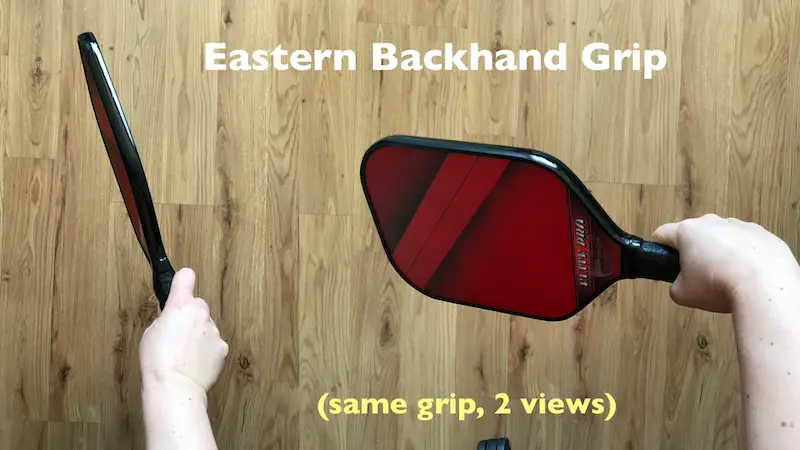
The reason that this grip is ideal for this shot is that when you turn to initiate the stroke your paddle face is pointed away from you and the edges are up and down comfortably so you can drop an edge into the swing.
You can even close it out a little bit as you come into contact and therefore you can easily drive straight through it and flatten it out. Or, you can tip the paddle head down a little bit further and then come up and generate some topspin in that way.
So, it’s a very versatile grip that you can either drive through or hit topspin with and that’s ideal for variety options on the backhand drive groundstroke.
One of the keys to having a strong and consistent backhand is to have a strong and consistent contact point.
Whenever you’re contacting that ball, you want it to be at about the same distance and angle from your body. You want your arm position to be relatively the same from shot to shot and the way you achieve this is with proper footwork and creating good spacing.
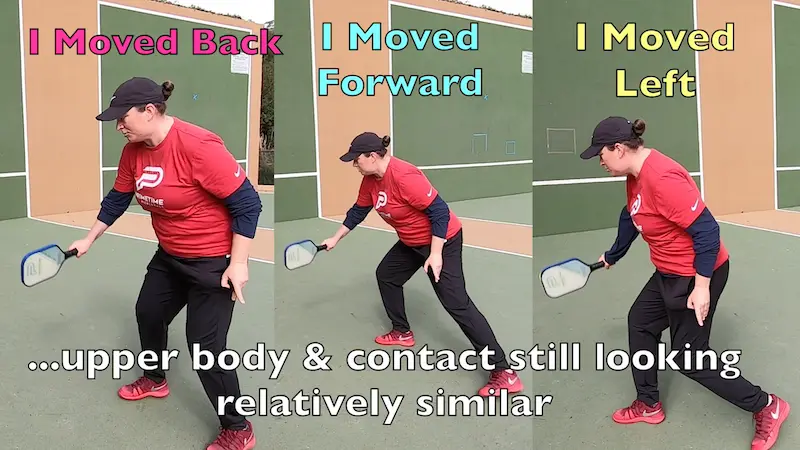
Now, it would be fantastic if we could be well balanced and hit every shot from a strong load up on the backhand followed by a strong step in.
Let’s say you’re a right hander loaded on your left leg, and stepping in and transferring your weight on to your right leg, and then finishing your swing beautifully every time.
The challenge with that is that pickleball is a dynamic game. The ball’s always moving and you’re not going to get there exactly right on time every time in order to achieve that perfect plant and step in directly through the ball every time.
You’re going to have to use some dynamic footwork patterns. There’s no way around it.
Let’s consider an example where you’re moving towards the right while hitting the backhand drive because it’s headed more towards your body and you have to get out of the way and create some space.
Ideally, you’d be able to do so quickly and with enough time to get a strong plant with the back leg and strong step in straight ahead. Ideally, your plant foot, after you’re done with the shot, doesn’t really move because you’re so stable and balanced and well positioned ahead of striking the shot and you’re well balanced throughout the whole shot.
There are many, many shots where you’re simply not going to get to them perfectly on time to allow you to step in fully balanced like that. You’re going to still be in motion either somewhat to the left or to the right as you hit the shot.
It will happen… A LOT! It’s not an exception, it’s a regular event.
But, there’s a way to stay dynamically balanced so that by the time you’re done with the shot you’re still balanced. As you hit the shot you are in motion but in a very balanced way.
So, you’re dynamically stable and balanced rather than just statically stable. That’s okay because, as mentioned, that’s going to happen many times. You just have to know the appropriate footwork patterns and train yourself to use them when needed.
Now, I’m about to describe an example where you’re moving towards your left and hitting the shot.
In this scenario you don’t get your plant foot, in this case your back foot, which is your left (on the backhand side) because you are a righty, all the way behind the ball. You have to plant it short of getting it behind the ball.
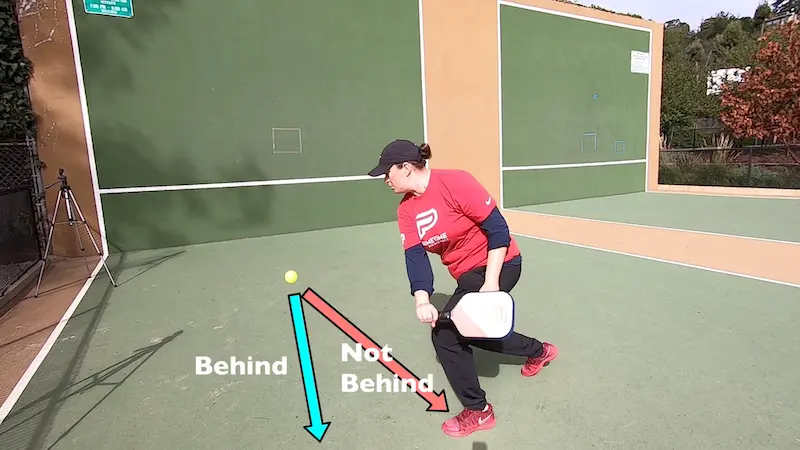
And then, as you hit, you step across your body with your right foot and really use a dynamic stance here. You plant, you hit and then you catch yourself with your right leg.
As opposed to planting, stepping in, and then hitting, more in unison and with more of your body momentum headed towards your target.
This is what you’d like to see in an ideal world if you were able to get perfectly set up and balanced in a more statically balanced fashion each and every time which as I’ve said is virtually impossible.
You will constantly see high-level players using these more dynamic footwork patterns as they’re playing because it’s really not possible in today’s high paced, fast game, that continues to get faster and faster, to get so perfectly set up each and every time.
It’s important to understand that and get used to it during play.
You’re going to want to use these dynamic movements to hit the best possible shots. You can also work these on the wall as you move the ball around from left to right and back again.
When you implement the tips I’m sharing in today’s video I’m confident it will help your game.
Drill # 2 – Backhand Slice
The next shot that we’re going to work on against the wall, on the backhand side, is the backhand slice.
Now, before I move on to covering the differences between the backhand drive, whether that be more of a flat or topspin drive, versus the slice, I’m going to cover some of the similarities between them.
These points are non-negotiable.
Backhand Drive & Slice Similarities
You must do this on all of your backhands if you ever hope to have a really strong reliable backhand that you love.
Number one is a really big shoulder turn. This is where you’re really well turned to the point where your right shoulder is even a bit more to the left of your left shoulder. So you’re very well rotated. You have your paddle set high here because you’re going to drop into the swing. On the backhand slice it’s a little bit more open.
You’re going to get the contact in front on both. On the backhand slice it’s a little bit further back but it’s still very well in front of you for a really strong and stable contact.
Lastly, you still need really good footwork on the backhand slice. You can use the same footwork patterns I discussed earlier if you need to get yourself dynamically balanced. Whether that be you’re moving to the right or to the left or even if you have to back up. You still need to use your legs well and you’re going to use very similar footwork patterns on both.
Key Tips Recap: number one big shoulder turn on both, number two contact in front of you on both, number three really good footwork to get good spacing between you and the ball. Use your dynamic footwork patterns as needed.
Backhand Drive vs. Slice Differences
Now we’re going to cover differences between the backhand drive and the backhand slice. We already touched on a few but we’re going to dive deeper into them now.
The first thing I want to talk about is the grip on the backhand drive. We use the eastern backhand grip and on the backhand slice we’re going to be using the continental grip.
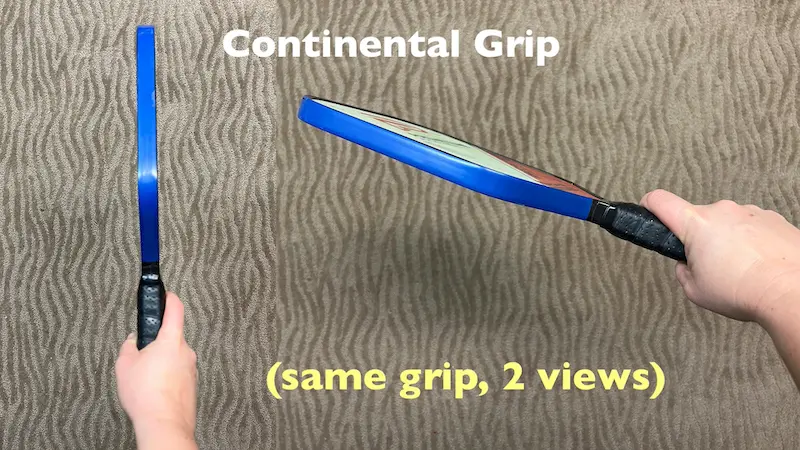
How you find the continental grip is, again, if you’re holding your edges up and down you’re going to now place your index knuckle on the 45 degree portion of the grip. That’s between the top, which is the edge side, and the paddle face side, which is the right. You’re going to put your index knuckle right in the middle of that on that 45 degree angle of the grip.
Below is a side by side of two views of the continental grip so that you can get a better sense of it.
Now let’s discuss some of the differences on the stroke.
In the image below I’m turned. On the right I’m ready to hit a slice and on the left a backhand drive.
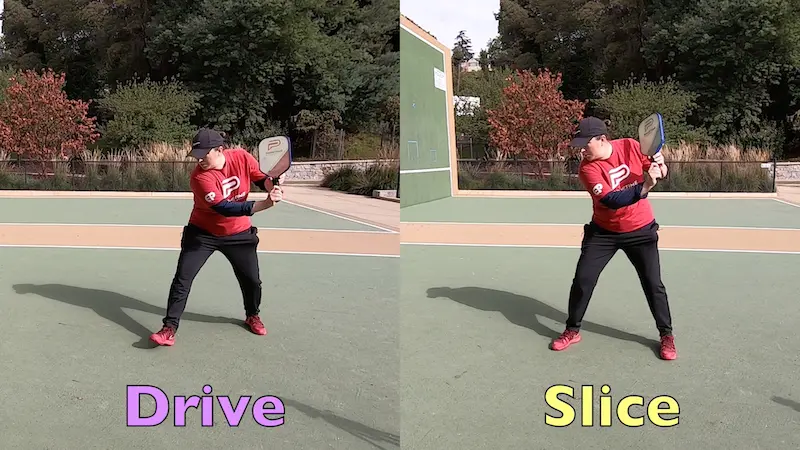
And as you you can see in the image below on the right, my paddle face is slightly more open as I drop into the shot. Here we’re entering contact. And, as you can see, on the backhand drive I have the paddle head dropped a bit lower so that when I come through the shot on the backhand drive. I’m going directly through the ball. On the slice I would cut more.

If you think about the ball being an orange on the backhand drive, you would hit through it. You’re going to really smash it true and through like the orange is going to explode. Whereas on the slice you’re really trying to strip that peel off the orange.
I find that that’s a pretty good visual to think about when you’re trying to slice versus a drive.
On the slice you’re not hitting true and through the shot, you’re more shaving the peel off the orange.
Drill #3 – Backhand Dink
For this dinking drill, you’re going to scoot up closer to the wall and simulate being right up there against a non-volley zone line. You’re going to work on your backhand dink.
You really want to get your backhand dink to a place where you can hit a hundred plus against the wall with no problem. It should be as if you could even just keep going beyond that, to the point where you have to catch the ball and stop because it’s so good that you could just keep going forever. You have a really solid dink if you can get it to that place.
You also want to make sure that your feet are up against the line and that you’re in a more open stance because that’s how you’re going to be dinking when you’re up there at the non-volley zone line. You won’t be stepping in on your dinks unless you absolutely have to. At times, it will be necessary.
You want a very small efficient movement which means practically no backswing.
You should set the paddle down right next to your body and it shouldn’t really go behind you. Keep in mind you’re going to have a continental grip on this as well, just like the backhand slice, and you’re going to just be nudging and tapping that ball over the net very efficiently.
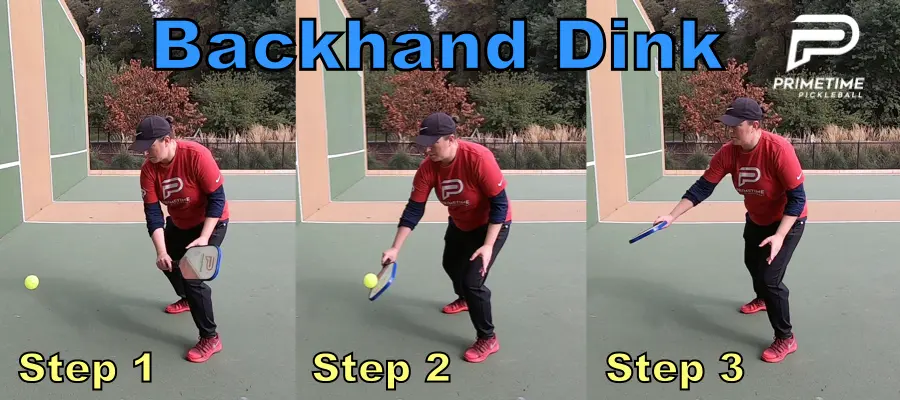
You can even play with a little bit of slice, a little bit of topspin, if you wish, to get working on those different spins in your dinking.
Drill #4 – Driving Backhand Volley
We’re going to move on to the driving backhand volley.
We’re going to do this with a continental grip as well.
It’s a very efficient stroke. There’s not a whole lot of leg movement on this because there’s really just no time.
You’ll want to hit it off the wall and hit it hard enough, but not so hard that you can’t control it, so that it gets back to you at at least waist height and preferable somewhat higher. If you need to slow it down to maintain control then you’ll need to hit it higher of the way. As you gain more control, you can ramp up the speed slowly and as you do that you bring the heigh of the impact off the wall down progressively.
Once you can do this at high speed, This will really help you improve your hand speed. The skills you gain from this drill will come in very handy in shootouts at the net which are those times when you’re attacking and also when you’re being counterattacked.
As we mentioned, you should up your pace as you go along. Not necessarily in the same session but over time. Doing this over a few days and weeks will really help you get better at quick exchanges and you will stand a much better chance of coming out ahead on those because your hands will get much faster.
Remember, the technique on this is very small and efficient. As minimal as you can make it.
The paddle shouldn’t go behind you at all. Even less so than on dinking. You just push out forward and you reset very quickly. No time for anything else really. You have to be extremely efficient on this shot.
This is really going to help you dramatically improve your hand speed and your quickness.
One additional thing that I did want to point out here, as compared to when you’re dinking, is that you’re going to have to have a firmer grip because you do need some more rebound off the paddle. When you firm up your grip that’s when you do get more of a bounce off the paddle.
But, you still don’t want to have a death grip where you’re holding it as tight as you can. You just want to have a nice firm grip that’s going to provide you some rebound because this is not a soft shot. You’re hitting it at the same pace as it came to you or harder.
Drill # 5 – Backhand Reset
Next and last, but certainly not least, is the backhand reset.
I want to point out that some of you may be at the stage where you’ll want to work on this a lot. Possibly to the exclusion of everything else.
I say this because the reset is one of the things you want to be working on the most if you’re striving to jump into that 4.0 plus level.
If you’re struggling with any of the shots that we’ve covered up until now then work on those first and get those all nice and locked in as best you can.
But, once those other four are pretty well dialed in, you’re going to want to work a lot on your resets. In fact, you want to spend the most amount of time on your resets because that is the shot that separates the best from the rest.
It’s the ability to defend and get yourself out of a jam and back into the point that is somewhat like stealing points from your opponents since they can’t close it out. When you have that skill, you really are a force to be reckoned with.
Let’s dive into the drill description. I want to point out that this is almost like a two shot sequence on repeat.
The first shot is really more of a feed. So, by no means should you look at this as a strategic shot. You’re really just striking it hard at the wall to try to set up a reasonable reset shot for yourself. Similar in nature to a ball you might see in a game that needs to be reset.
First you can start off by not hitting it so hard and as you get better you can really whack it and hit it harder and harder. Make those resets tougher and tougher. Always start slow and gain control at that speed before advancing to higher speeds.
You want that reset to just clear the net (not by a whole lot) so that it drops towards their feet because if this reset pops up you’re going to get nailed on the very next shot.
So, really try to keep those resets nice and low. Not too much movement on the paddle face. You just kind of stick it out there and block. You might push it a little bit if your feed off the wall wasn’t very hard but if you ripped it off the wall then you hold your paddle there and don’t move it much at all.
It’s all about grip pressure and paddle face angle during a reset/block.
This is how you’re really going to train yourself to feel what needs to be done depending on what shot is coming to you. That’s something that you have to just figure out the feel of to get really good at it.
It really comes down to developing the feel of what I’m talking about.
As I mentioned, grip pressure and paddle face angle are crucial so if you popped it up too high chances are your paddle face is too open. Next time you have to close it out a tad on a similar ball.
If the ball didn’t go anywhere, your grip pressure probably has to be a bit firmer so you get a little bit more rebound.
Or, if it went too far then your grip pressure was probably too tight and maybe you pushed it when you shouldn’t have. You should have just held your paddle there more stably instead.
Final Thoughts
No amount of YouTube videos and hearing these tips can substitute the fact that you have to get out there and feel it for yourself. Hit and adjust and then do it again depending on what came and what happened.
That’s how you’re going to get really good at this. In fact, mastering any skill in pickleball is about getting out there to hit it and read what happened and adjust on the next similar one. This is a very good concept to apply to all the drills that we’ve discussed here.
These are five great, yet simple, backhand drills that you can do that are really going to elevate your backhand to that next level. Very soon your backhand won’t be a weakness anymore.
Just like I turned around one day and mine wasn’t anymore either.
All of a sudden people can’t go there and they’re gonna have to find something else to do to beat you and that’s going to become a tall order when you have a strong backhand and a strong forehand.
Now you’re really going to do some damage and you’re really going to be a presence on the court that people will want to play with and fear playing against. You’re going to have great games and a whole lot of fun.
You’re going to start to play at a high level and progress to the top courts as your weaknesses shrink and you turn them into stable shots and maybe even weapons. As your weapons improve it’s just going be so much fun and you’re going have a blast out there doing some real damage out on the courts.